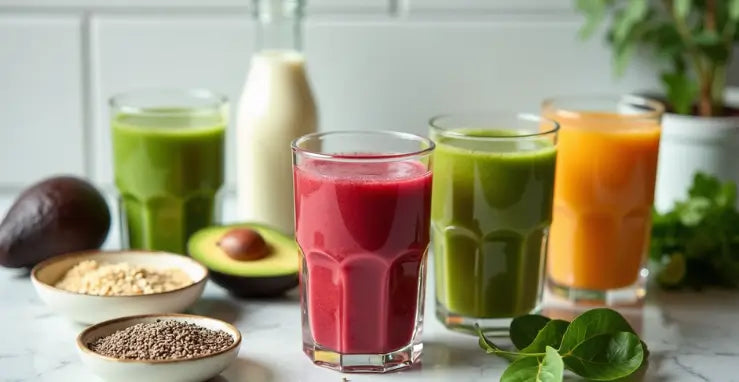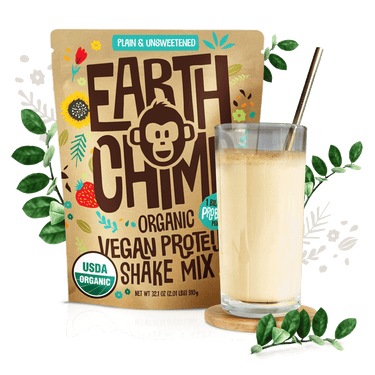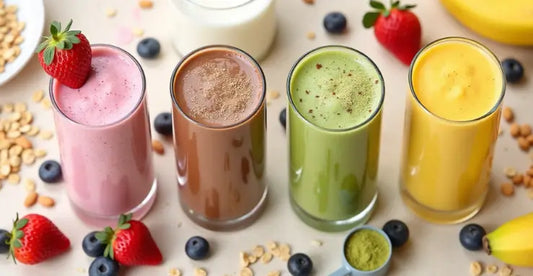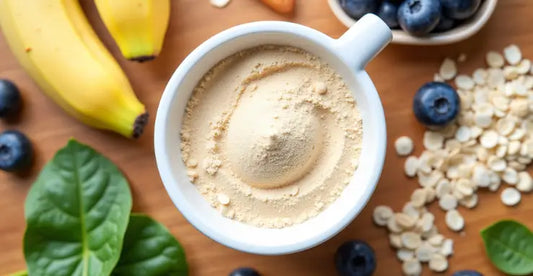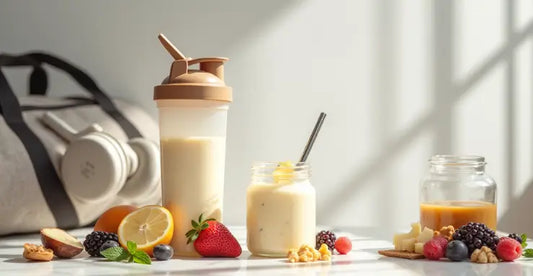Juicing is a popular way to enjoy more fruits and vegetables in your day. Whether you're on a juice cleanse or just love a fresh glass of cold-pressed juice, it’s an easy habit that can feel both refreshing and healthy.
But while it’s packed with flavor and natural vitamins, juicing often skips over one key part of nutrition: protein. Since juicing removes most of the fiber and pulp, you're left with a drink that’s low in one important nutrient your body needs.
That might lead you to ask: How can I still get enough protein if I’m juicing regularly?
The good news is, it’s totally possible. With the right ingredients, you can add protein to your juices in a simple and enjoyable way. In this guide, we’ll look at how to get protein while juicing using easy-to-find plant-based foods and clean protein powder options, without changing the taste you love.
Why Juicing Often Lacks Protein
Juicing can support your wellness goals, but it may fall short on protein. To understand how to build a more balanced diet, read our guide on clean eating.
Most fruits and vegetables are naturally low in protein content, especially when juiced alone. That’s why a regular juice cleanse or daily juice habit may need a little help when it comes to getting enough protein.
Best Plant-Based Protein Sources for Juicing

If you want to get extra protein while juicing, there are plenty of simple, whole foods and clean powder options that work well with your favorite blends. These are easy to use and fit into your routine, especially when you're on a vegan diet. You can add them to juices and smoothies or use them in thicker blends for a more filling drink.
You can use them in juices and smoothies, or even mix them into thicker blends for a more filling drink. Below are some of the best plant-based protein options that are easy to add and full of nutrients.
1. Chia Seeds
Chia seeds are small but powerful. Just two tablespoons offer about 4 grams of protein. They're also high in omega-3 fatty acids, fiber, and other helpful nutrients.
When soaked, they form a gel-like texture that works well in juice. You can also stir them into a blend after juicing. These seeds are a simple way to boost the protein content of your drink.
2. Hemp Seeds
Hemp seeds are another excellent source of protein. 2-3 tablespoons give you 11 grams of protein, making them one of the most protein-rich plant options.
They have a mild, nutty taste and go well in both green juice recipes and fruit-forward blends. Sprinkle them in or blend them up for a subtle but powerful protein boost.
3. Ground Flax Seeds
Flax seeds are easier to digest when ground. One ounce of ground flax provides about 5 grams of protein. These seeds are also rich in omega-3 fatty acids and fiber.
The texture is slightly gritty, so they’re best in blends with stronger flavors like citrus or root-based juices. They're a versatile and beneficial add-in for plant-based diets.
4. Oats
Oats aren’t just for breakfast. A half cup of oats has around 3 grams of protein, and they add a naturally creamy feel when blended.
They're not ideal for juicing alone, but they work well in smoothie-style blends where you're keeping the full ingredients. They’re also a great way to make your drink more filling and satisfying.
5. Spinach and Kale
These leafy greens may not be the highest in protein content, but they still bring value to your drink. One cup of raw kale has about 2.2 grams of protein, while spinach offers around 0.9 grams.
What they may lack in protein, they make up for in nutrients. Both are rich in vitamins, minerals, and antioxidants, making them a smart base for many juice recipes. They’re also considered superfoods, so adding them can enhance your overall nutrition in more ways than one.
6. Avocados
Avocados bring both protein and texture. One avocado has about 4 grams of protein, plus healthy fats that help you feel full longer.
They blend well into juices and smoothies, creating a smooth, rich, and nutritious texture. If you want a creamier drink, this is an easy ingredient to use.
7. Vegan Protein Powders
If you want a quick and convenient way to add protein, vegan protein powders are a smart choice. Many protein powders today are made from peas, rice, or other plant-based sources and contain up to 20 grams of protein per serving.
Just be sure to pick one that’s free from added sugar, artificial flavors, or preservatives. A clean protein powder blends easily into any juice, smoothie, or protein shake, making it a reliable option when you're short on time.
Tips for Mixing Protein Powder into Your Juices
Best Liquids to Use as a Base
Choosing the right liquids to mix can make a big difference. The base you use affects both the taste and how thick your drink will be.
-
Almond milk is light, slightly sweet, and works well with most protein powders. It adds a gentle nutty flavor without being overpowering.
-
Oat milk is creamy and smooth. It gives your juice a thicker texture and blends easily with fruits and high-protein add-ins like seeds or oats.
-
Water is the most neutral option. It doesn’t affect the flavor but may not fully smooth out the powder, depending on the type.
Try each to see what fits your taste and how it works with different ingredients in your juice recipes.
How to Avoid Gritty or Chalky Texture
One of the biggest concerns when adding protein powder or seeds to juice is getting a chalky or gritty result. To keep things smooth:
-
Always blend instead of stirring your protein juice. This helps break down the powder and mix everything evenly.
-
Soak chia seeds or ground flax seeds in water for a few minutes before using. This softens them and improves digestion.
-
Use fine-ground versions of any dry ingredient, like oats or flax, to avoid clumps.
Making these small adjustments can enhance your drink’s texture and make it much easier to enjoy regularly.
Wrapping Up: Making Juicing and Protein Work Together

Juicing helps you enjoy more fruits and vegetables, but it often lacks protein. The good news is, you can fix that with a few simple add-ins.
If you're looking for a fast, clean, and smooth option, EarthChimp’s vegan protein powder is a great fit. It blends well with any juice or smoothie and is made without artificial flavors or added sugar. It’s a smart way to get more plant-based protein into your day.
For more inspiration, you can also explore vegan protein recipes that use whole foods, nut butters, and seeds to keep your drink both nutritious and enjoyable.
In the end, you don’t have to choose between juicing and getting enough protein. With a little creativity, you can enjoy the best of both — one glass at a time.
Frequently Asked Questions About Juicing with Protein
Which Vegetables Are High in Protein?
Spinach, kale, broccoli, peas, and Brussels sprouts are some vegetables that contain more protein compared to others.
Can I Add Protein Powder to My Green Juice?
Yes, you can add protein powder to green juice. Blending it works best for a smoother texture.
How to Get Protein While on a Liquid Diet?
Use plant-based protein powders, add nut butters, or include blended seeds and non-dairy milk in your drinks.
Does Juicing Take Nutrients Away?
Juicing removes fiber but keeps most vitamins and minerals. Some nutrients may be lost if juice is not consumed fresh.
References:
- https://fdc.nal.usda.gov/food-details/170554/nutrients
- https://www.healthline.com/nutrition/6-health-benefits-of-hemp-seeds
Disclaimer:
This statement has not been evaluated by the Food and Drug Administration. This product is not intended to diagnose, treat, cure, or prevent any disease.

